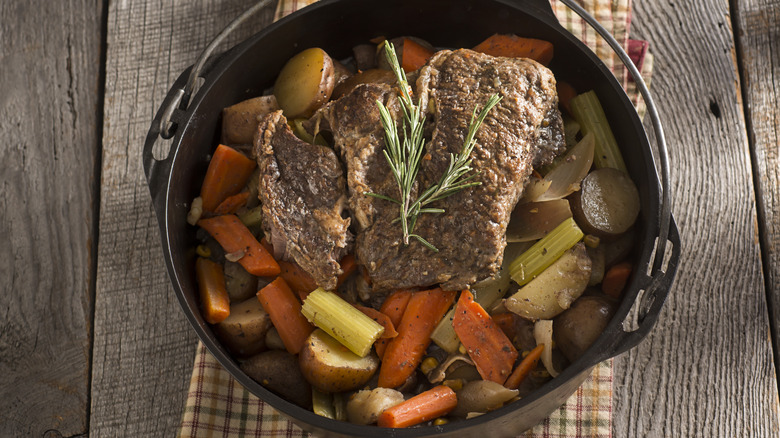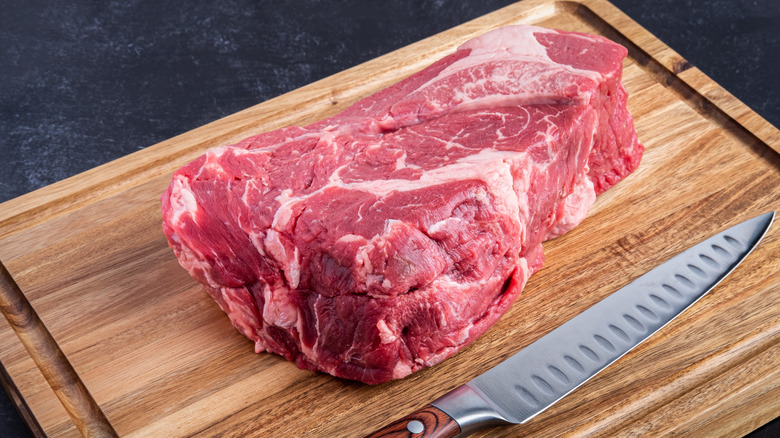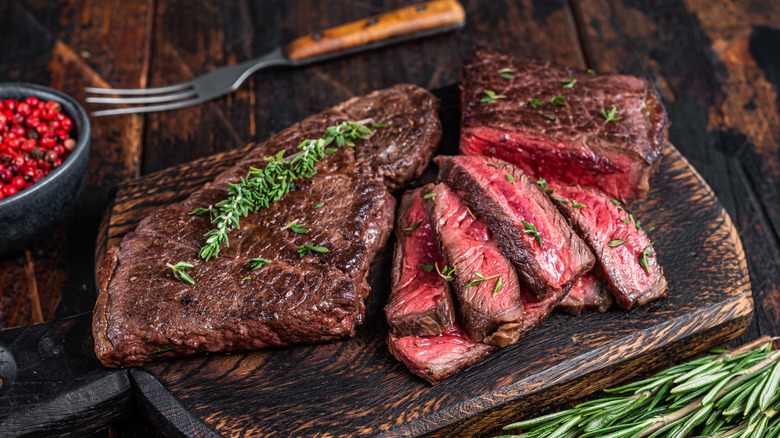The Worst Cut Of Beef For Pot Roast (And What To Use Instead)
Pot roast is one of those classic meat dishes that have long stood as a pillar of American home cooking, and in particular Sunday dinners. And while you can certainly use a number of cuts of beef for a great pot roast, there are some you want to avoid, and skirt steak is chief among them.
Skirt steak, which comes from a cow's diaphragm, is a great cut of meat, with a rich, beefy flavor. But there are definitely times you want to avoid it, and pot roast is a great example. The trouble with skirt steak in this context is that while it's tough and does have good marbling — qualities you want in your pot roast beef — it just doesn't do well with low and slow heat, in part because it's so thin relative to a lot of roast cuts. Skirt steak requires high heat and short cooking times lest you under or overcook it, and that's not really something you can do in a slow cooker (which is one of the best ways to make a pot roast).
Instead of skirt steak (or its cousins flank and hanger steak), what you're looking for is a cut of beef with a lot of connective tissue that also responds well to low and slow heat. The reason is that low/slow heat interacts with the collagen in connective tissue-laden beef, resulting in tender, delectable meat. Luckily, you have a bunch of options there.
You want to use meat with a lot of connective tissue
When meat with a lot of connective tissue is cooked on high heat, it tends to become both tough and dry (this is why you should avoid grilling brisket at all costs). But when given adequate time to cook slowly, the collagen in beef's connective tissue breaks down, becoming gelatin and essentially basting the meat in its own juices. This principle is perfect for pot roast, which is already meant to be cooked on low heat for a period of hours.
Luckily, there are plenty of cuts of meat that are perfect for pot roast. In addition to the aforementioned brisket, chuck roast is a cheaper option with a strong beef flavor and a decent but not overpowering level of fat, while rump roast and bottom round roast are great if you want a particularly lean cut of meat. Beef shanks are so full of cartilage that they sometimes get forgotten, but that very quality makes them ideal for pot roast. Short ribs are also good here — but be aware they tend to be a little bit pricier.
Skirt steak does well in high heat preparations
It's best to cook skirt steak on intense heat, as a quick sear on high heat will brown the outside perfectly while preventing the center from overcooking. Grilled skirt steak with chimichurri is a great option for this reason, as is any grilled preparation. Similarly, skirt steak is great in tacos, where it's one of the classic cuts used for carne asada. The high heat of a screamingly hot wok also means skirt steak is a fantastic choice in stir fries.
You should also know the difference between the two cuts of skirt steak: inside skirt and outside skirt. They have similar properties, but cook slightly differently, as outside skirt tends to be thicker, more tender, and more uniformly-shaped compared to inside skirt. For this reason, professional kitchens get the majority of outside skirt, so most grocery store skirt steaks will actually be the inside cut. Whichever you choose, you'll want to cut your skirt steak into thin slices going against the grain so it's even more tender and easier to chew. Marinating skirt steak can also make it less tough.
The general rule is this: If you're looking to grill or pan-sear a steak on high temperatures, skirt steak is ideal. Just keep it away from the slow cooker and your Sunday beef pot roast, and it'll treat you well.


